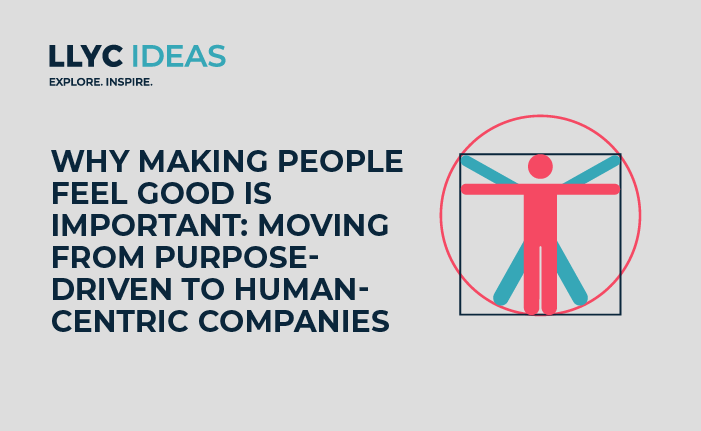-
TrendsPublications and Reports
-
CountriesGlobal
The relationship between companies and people is changing. In the past, a brand was expected to deliver what it promised in terms of product and service, preferably at an affordable price. Then, transparency and care for the environment were demanded. After that, the strategy shifted to putting the customer at the center: understanding them in order to design solutions that best satisfy their needs. Today, the concept is human-centric, focusing on something as simple as making people feel good.
The report titled ‘Why Making People Feel Good Is Important: Moving from Purpose-Driven to Human-Centric Companies,’ prepared by LLYC, reveals the reasons why brands need to embrace this strategy and how they can develop a methodology to build a positioning plan that connects with any of their stakeholders, thanks to data, and generates a positive influence on them, whether they are customers, employees, investors, or suppliers.
“You have to think more about the people than the product. If we want to make someone feel good, we must first get to know them, and to do that we must understand what worries them, what they do to resolve those feelings and where. Ultimately, it boils down to analysis. Nowadays, there is nothing better than data to achieve a higher probability of success. By putting people at the center of decisions and actions, brands can build more valuable and lasting relationships with their customers,” says Carmen Gardier, Senior Director of Digital Influence at LLYC in the Americas and one of the authors of the report.
How to develop a human centered methodology
To make people feel good you need to apply digital influence in five stages:
– Know. The context is increasingly unpredictable. Therefore, any approach must begin by understanding the current state of the society with which we want to connect, understanding the business challenge and complementing it with knowledge about industry trends, competition, the social-political context and technological trends. Thanks to this phase, it will be possible to establish the challenges that are necessary to connect with key people.
– Listening. This phase focuses on understanding what the consumer you want to connect with says, does, and thinks. Nowadays, we have access to a wealth of information. Intelligence tools can be employed to develop analysis and measurement models that integrate diverse data sources, thereby providing structure and value to acquire knowledge that is closely aligned with reality. This stage assists us in aligning brand challenges with people’s needs.
– Empathize. Knowing and listening form the foundation upon which we must work if we want to implement an empathetic conversation model. Generative intelligences enable us to explore novel ways of thinking about and understanding people, adding an extra layer of depth to our empathetic capabilities. They assist us in challenging assumptions, exploring diverse perspectives, and generating fresh ideas that facilitate deeper connections with people.
– Ideate. Once the analysis process (knowing, listening and empathizing) is complete, the ideation process begins. Here we must find different solutions for different people. At this stage, it is important not to lose focus: you already have the necessary data to be able to make informed decisions. The needs of the customers are the ones that should guide the definition of the right messages, in the right format and at the right time. It is essential to have the ability to adjust and fine-tune the approach to meet people’s needs effectively.
– Implementation. This is the final phase of the process, although in many cases, when undertaking a digital communication project, it often becomes the sole step. Implementing without knowledge, without listening, and most importantly, without empathizing with the people we aim to connect with, leads to a one-way communication process where brands speak rather than engage in a conversation. As a result, there will be no focus on generating positive conversation advocates.
Read the full report here.



